Most modern Garmin Smartwatches now come with a Barometric altimeter built in. This uses air pressure to calculate your current elevation. You can also use this as normal barometer to view the current air pressure which can give you guide if the weather is changing. Some watches even have the option to alert you about coming storms based on pressure changes.
Out of the box, the watches with a barometer sensor will automatically determine your elevation changes during any relevant activity (hiking, climbing, trail running, etc). This automatic calibration mode is great for most uses, such as seeing the total elevation change you have done for hill training or steep hikes. This mode means you don’t have to calibrate your watch every time you do an activity. Sometimes you will notice that your height readings are a bit out – this can occur for several reasons. For example, if you haven’t used the GPS in a while, if you have flown on a plane with a pressurized cabin or a big storm has come through. For more accurate altitude measurement, Garmin allows you to have a bit more control over how the altimeter functions. The barometric altimeter in your Garmin watch has three distinct modes.
Auto (default settings) – The watch will monitor changes and automatically switch between altimeter or barometer modes. It also uses the GPS as part of its calibration algorithm when it is used.
Altimeter – The watch is locked in altimeter mode, and all changes in pressure will impact the elevation reading. This mode is best for activities with a lot of elevation changes. For best results, the watch should be calibrated hourly, but in calm weather once per day is often enough.
Barometer – The watch is locked in barometer mode, and all changes in pressure will be considered due to weather and changes in ambient pressure. This mode is best used for activities without a lot of elevation changes.
Going a little deeper into these modes. The auto function is great for people who want a general guide as to their altitude but are more interested in how much it has changed. If you need precise figures, then calibration is a must. If you’re doing any climbing, hiking or activities that will often change in elevation, then you should set your watch to altimeter mode and calibrate it when you set out.
To change your watch from auto to altimeter follow these steps:
- Long Press up/Menu Button
- Select Settings option
- Select Sensors
- Select Barometer
- Select Watch Mode
- Select Altimeter
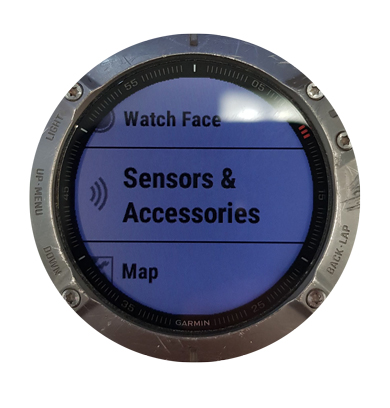

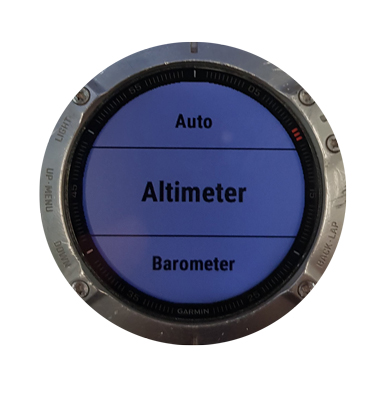
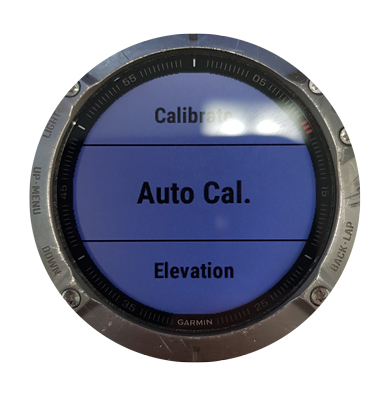
At the start of an activity requriing elevation (altitude) display, you will need to re-calibrate the device. To do this, you will need to get to the altimeter widget, select calibrate and either use the GPS* given elevation or if you know your current elevation enter that in manually. If you are using a topographical map this is an easy way to find your elevation. If your watch has maps in it, it will even give you the option to use the map to calibrate – select the “Use DEM” to do this. It stands for Digital Elevation Model if you are wondering.
Setting your watch to Barometer mode is useful when you're doing activities outside but your elevation won’t be changing significantly. This allows you to use your watch to notify of impending weather changes (instead of elevation changes).
*Keep in mind GPS elevation isn’t super accurate, it can be up to 50 meters out depending on the GPS signal strength, which is why Garmin have put the barometer in the watch in the first place. Your relative accuracy (point to point differences) will still be quite good when calibrated to GPS, so if you don’t know your current height this is better than nothing.
My Barometric Sensor is off/fluctuating – How to fix
Over time your barometric sensor can become inaccurate due to outside interferences.
Factors that could be affecting your sensor and solutions
Rapid changes in weather
- The unit will resume accurate altimeter readings when weather condition settles
- Consider calibrating sensor after weather conditions have settled
Pressured cabins
-Pressurized cabins in aircraft will really confuse the watch’s auto calibration. Make sure you manually calibrate after you land.
Debris Blocking the sensor port
- If you have tried calibrating your watch and it still doesn’t give the correct reading, your sensor port could be clogged up. The sensor port is located between the Start/Stop and Back/Lap buttons. Clean the port by rinsing it with water. Do not insert anything into the ports, as this may damage the sensor. Make sure you calibrate the watch again after cleaning to ensure you get the right reading.
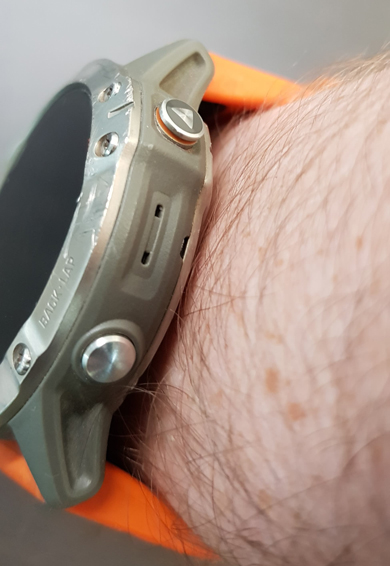
Extended Periods of time in a fixed location
- For best accuracy, +/- 50ft (~15m), calibrate the pressure sensor to a known elevation regularly
Going from exterior non-pressurized/non-climate controlled environments to interiors that are climate/pressurised
- Calibrate sensor when you’re outdoors


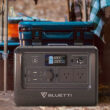




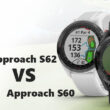



I upgraded from a Fenix 3HR to the Enduro so you can imagine learning curve of a new watch with so many new and unfamiliar settings to go through. My F3HR has had a lot of race mileage and its distance and elevation accuracy is well regarded for being very close to official figures from event organisers.
Straight out of the box, the Enduro’s default settings reported distance fine but elevation gains were way too generous. Took me a few months to figure out the causes and fixes and to-date, I found the following changes were required for the watch to function properly:
1. GPS Recording: Every Second
2. Barometer Watch Mode: Change from Auto to Barometer
3. Altimeter: Auto Cal. | During Activity: OFF | Not During Activity: OFF
If Auto Cal. is turned on during activity, Altimeter can only use GPS but when it’s Off, DEM becomes available. I make it a habit of calibration before each activity be it a Run, Trail Run or Ride. I recently relooked at #2 and turned Barometer Watch Mode back to Auto and it seems to work fine where previously during a trail run, Auto jacked up my Elev Gain numbers by a lot. I’m beginning to think it’s #3 that’s the real culprit.